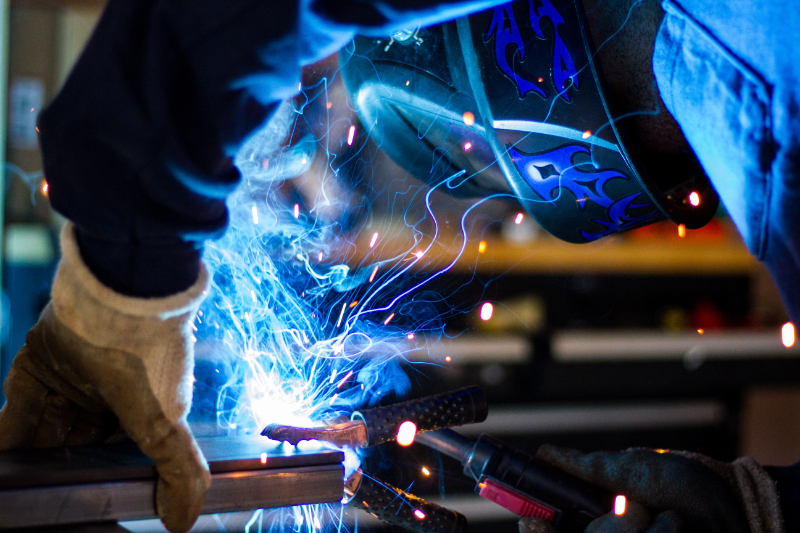What is oxy-fuel cutting in metal fabrication. We explore everything you need to know about oxy-fuel cutting, including its principles, the types of gases used, and its advantages for various metal fabrication projects.
What Is Oxy-Fuel Cutting?
Oxy-fuel cutting, commonly known as flame cutting, is a fundamental process frequently used in the metal fabrication industry. This traditional technique makes use of a combination of oxygen and combustible gas - often including the likes of propane, acetylene, or propylene.
This mixture is then directed onto the metal's surface to heat it to a point of liquifying before removing it with a strong oxygen current. Broadly speaking, the heat provided by the flame then provides a catalyst for cutting the metal.
After that, the available or unused oxygen quickens the process of oxidation - which essentially decouples the metal. Materials that are mainly cut through this technique include steel and iron, due to their inherent ability to oxidise or form what is known as 'slag', when exposed to a range of heat conditions.
This approach to cutting metal provides efficiency when dealing with metals that have varying levels of thicknesses, from less than an inch to more than a foot. Overall, oxy-fuel cutting brings a highly practical cutting solution to metal fabrication industries.
What Is The Process Of Oxy-Cutting?
Oxy-fuel cutting is a procedure that falls under the umbrella of metal fabrication; the technique involves an intricate blending of a fuel gas flame, from propane to biodiesel to pure oxygen. The combustion process produces a controlled flame that's hotter than conventional air-fuel mixtures.
The main component of the process is the 'torch', with a 60 or 90-degree tilted head - which emits a jet of oxygen for the cutting process. The torch is designed to prevent the need to move the nozzle as you change the cut's direction, providing a smooth and efficient operation.
The high temperatures, nearing 3,500 °C, generated by the oxy-acetylene flame raise the temperature of the metal workpiece around the point of the desired cut. This is not aimed at melting the metal, but to bring it to its ignition temperature.

The critical part of the oxy-fuel cutting process happens when a high-pressure stream of pure oxygen is released onto the heated spot - this oxidises the metal and turns it into liquid iron oxide.
A trigger on the torch then propels the extra oxygen at a higher pressure down a third tube located on the torch, sparking a metal burn. This reaction leads to the creation of a molten oxide, which is then blown through, hence producing a narrow, sharp-edged gap on the workpiece - this gap, known as a kerf, is a defining attribute of the process.
The movement of the torch creates a narrow cutting slot, with the excess slag then removed from the kerf. The quality of the cut relies heavily on factors such as the material's surface condition, the speed of the cut, and the material's thickness.
The process not only ensures a reliable cut quality but also guarantees that the fabricated components will be at their finished sizes without needing further processing. Oxy-fuel flame cutting also excels in producing V, Y, X, and K bevels; making it a versatile and effective method.
Advantages Of Oxy-Cutting
Oxy-fuel cutting is an effective method for metal fabrication, as it provides a range of benefits. The most prominent advantage is its low operating cost, making it an economical choice even with large jobs. This technique can quickly and efficiently cut through thick metals - enhancing productivity and work speed. The compact and portable nature of the equipment used for oxy-fuel cutting is another advantage. It doesn't require an external power source, making it ideal for on-site applications where power may be limited or non-existent.
This portability allows users to take the necessary tools to any location; substantially reducing the restrictions on where work can be undertaken. This method of metal cutting also makes precision a priority. The final cuts are clean, smooth and free of slag; this results in minimal clean-up work, which in turn saves time.
Moreover, oxy-fuel cutting provides fabricators with extensive design flexibility, as the process can be adapted to cut various shapes. This feature allows for creative freedom and opens up a wide variety of potential design options. In essence, oxy-fuel cutting is a go-to solution for metal fabrication due to its economical nature, portability, accuracy, and design flexibility.
Oxy-Cutting vs Plasma Cutting
Oxy-fuel cutting and plasma cutting are two widely used techniques in metal fabrication. Both offer unique advantages, but there are key differences between them. Oxy-fuel cutting uses a mix of fuel gases and oxygen; this combination produces a flame capable of cleanly slicing through various types of metal.
This method, however, is particularly effective when applied to thicker metals. The robustness and cost-effectiveness of oxy-fuel cutting equipment make it a go-to choice for many, especially considering the lower initial and operational costs compared to plasma cutting.
Plasma cutting, on the other hand, makes use of an electrical arc and a stream of compressed gas in order to cut through metals.
This process generates a high-intensity, searing-hot plasma stream that's perfect for cutting thin materials quickly and easily. While plasma cutting is typically faster, it does come with higher running costs.
Nevertheless, its precision and speed make it an invaluable tool in many fabrication projects. To summarise, oxy-fuel is frequently chosen for its affordability and effectiveness in dealing with tougher, thicker metals, while plasma cutting provides speed and precision for the cutting and welding of thinner metals.

Oxy-Cutting vs Laser Cutting
Both oxy-fuel cutting and laser cutting are invaluable tools in the metal fabrication industry, but they both have different purposes. Laser cutting operates by directing a high-intensity laser beam at a material which results in melting and evaporating it; this technique enables a fine, exact cut that boosts precision, particularly on thinner materials.
Speed is another advantage of laser cutting; it can work at a faster pace, saving time in large-scale manufacturing projects. Laser cutting also delivers a clean, virtually burr-free final product. However, a notable downside is the higher price point and it also struggles with efficiency when applied to thicker materials.
On the other hand, oxy-fuel cutting relies on a stream of oxygen and a flame in order to slice through the material. It's a more cost-effective technique, especially when dealing with thicker or tougher materials. However, it should be made clear that the seamless no-contact finish that's achievable with laser cutting is harder to obtain with oxy-fuel cutting.
In essence, the decision to choose either oxy-fuel or laser cutting can depend on a range of factors, such as task demands, budget, and the desired level of precision. Each technique has its unique strengths and weaknesses, making them suitable for different scenarios in metal fabrication.
welding and fabrication near me in Kent?
If you require welding and fabrication near me in Margate, Kent or the surrounding areas get in touch today. Follow the link below to find out more about our metal fabrication services.


